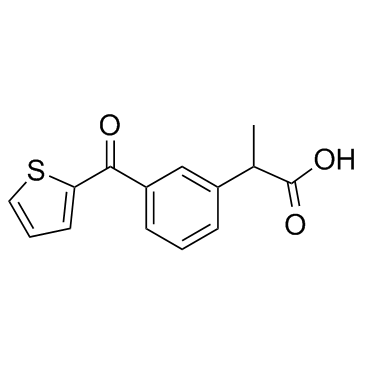Suprofen, a new peripheral analgesic.
R J Capetola, D A Shriver, M E Rosenthale
文献索引:J. Pharmacol. Exp. Ther. 214(1) , 16-23, (1980)
全文:HTML全文
摘要
The antinociceptive properties of suprofen [alpha-methyl-4-(thienylcarbonyl)benzene acetic acid] are described in a pathologically induced hyperalgesic model, the rat adjuvant arthritis flexion test. By using this assay, suprofen was characterized as an orally effective, non-narcotic analgesic with a rapid onset and 4-hr duration of activity. Suprofen is 50 times more potent than acetaminophen, five times more potent than codeine and equipotent to the new peripheral analgesics, zomepirac and diflunisal. In combination experiments, suprofen potentiates the analgesic effects of acetaminophen and, unlike morphine, the analgesic effect of suprofen is not blocked by naloxone. In other hyperalgesic assays, suprofen is an extremely potent inhibitor of arachidonate-induced writhing and is equipotent to morphine in the yeast-induced paw edema (Randall-Selitto) assay. Additionally, suprofen is inactive on the normal paw in the Randall-Selitto test, the mouse Eddy hot-plate test and the tail withdrawal reflex assay induced by warm water in rats, all sensitive tests capable of detecting central (narcotic) but not peripheral analgesics. Activity on prostaglandin biosynthesis from several species and tissues suggests that suprofen is a tissue selective inhibitor of prostaglandin synthesis. These experiments suggest that suprofen represents a new class of potent, orally effective, peripheral (non-narcotic) analgesics with potential usefulness in a variety of clinical pain situations formerly reserved for narcotics.
相关化合物
| 结构式 | 名称/CAS号 | 分子式 | 全部文献 |
|---|---|---|---|
 |
舒洛芬
CAS:40828-46-4 |
C14H12O3S |
|
Suprofen: the pharmacology and clinical efficacy of a new no...
1984-08-01 [Clin. Rheum. Dis. 10(2) , 353-68, (1984)] |
|
Suprofen, a potent antagonist of acetic acid-induced writhin...
1975-10-01 [Arzneimittelforschung 25(10) , 1505-9, (1975)] |
|
Renal effects of nonsteroidal anti-inflammatory drugs.
1988-01-01 [Agents Actions. Suppl. 24 , 95-106, (1988)] |
|
Significantly Different Covalent Binding of Oxidative Metabo...
2015-05-18 [Chem. Res. Toxicol. 28(5) , 886-96, (2015)] |
|
Mechanism-based inactivation of cytochrome P450 2C9 by tieni...
2009-01-01 [Drug Metab. Dispos. 37(1) , 59-65, (2009)] |